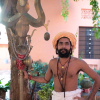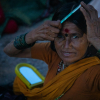Zeliangrong is a portmanteau of Zeme, Liangmai and Rongmei (Ze + Liang + Rong), three cognate groups of tribes. These three groups practise a number of traditional festivals. Though the festivals are observed under different names, they have similar themes and objectives. Among the traditional festivals of the Zeliangrong, Gaan Ngai, a post-harvest festival is the most important in all respects. The Zemei call it Hega Ngi, while the Liangmai call it Gin Ngi.
Gaan Ngai celebrations differ from one village to the other, but it is commonly celebrated for five days. On the first day, a pig is sacrificed. It is cooked and eaten together by the dormitories[1], along with the elders of the village. This is known as Jeigan Tumei. It symbolizes the solidarity and unity of the village as per Rongmei traditions.
In the afternoon, the boys of the dormitory, along with elders, march from the northern gate called Lang to the southern gate of the village announcing the commencement of sport competitions, Taophai Danchammei. Long jump and stone-throwing competitions among the youth take place in the presence of the villagers. When the competitions come to an end, the village elders proclaim the message of peace and love. Also the bereaved families pay homage to the departed souls on this day, by offering edibles and some drinks.
On the second day of Gaan Ngai, boys and girls of the dormitories perform a special dance. Only the unmarried can take part in this dance. It is performed in the presence of other village bodies. It is a way of showing love and respect to the village functionaries.
On the third day the village mourns for the departed souls of those who were members of the boys’ and girls’ dormitories. Condolences are offered early in the morning. On the same day, in the afternoon, a dance called Tuna Gaan Laam is performed by the boys and girls of the dormitories in order to recognise those newly admitted to the dormitories.
The fourth day, another dance called Napteng Laam is performed to welcome new families that have come and settled in the village. Hence this day is dedicated to recognising the new families as now part of the village.
The fifth day is dedicated to propitiation of deities. The Zeliangrong believe in the seven brother-gods. Homage is paid to them in the form of offerings and rituals. The festival comes to an end after this.
From time to time, as required, the number of days for Gaan Ngai may be increased. It can extend to over five days.
Different laams or dances are performed during Gaan Ngai. Tamchan Laam is performed only by the girls (unmarried) of the dormitory in the presence of the village functionaries. Boys and girls distribute drinks and edibles. Tuna Gaan Laam is a dance performed together by the boys and girls of the dormitories. Napteng Laam is another type of dance performed during Gaan Ngai, as well as other festivals. From year to year, new families join the village and become a part of it. Napteng Laam is performed in order to recognise these new families.
Many folk songs are sung during festivals, both group and solo. Katu Lu is a group song associated with sowing of seeds, specially while working in Jhum fields. Both Katu Lu and Laoreo Lu are sung. Majah Lu is a popular folk song. It can be sung on every occasion. Sometimes Majah Lu is treated as a devotional folk song because it includes prayers for blessings, prosperity and plentiful harvest. Another folk song sung during the festival is Lamlon Lu. Lamlon Lu may be compared to English serenades. It is for expressing romantic feelings, a solo song which reveals the emotional feelings of the singer. These are some common folk songs sung during the festival.
The rites and rituals performed during the festival are regarded as entirely religious. Najum Gaimei is one ritual for newborn babies, without which humans are not regarded as created by the greater god Tingkao Ragwang.
Over the years, certain elements in Gaan Ngai have slowly disappeared. Those parts of the festival that have no relevance in the modern day have gone.
[1] The dormitory is an important social institution which sustains the Zeliangrong society, religion and culture. Membership of the dormitory is compulsory for boys and girls so they are introduced at the pre-puberty stage. It meets the educational needs of the young men and women. It also meets the requirements of the village in terms of defense and the manpower required to organize public works, religious ceremonies and cultural festivals including dance and music. The Zeliangrong people believe in the divine origin of this institution.












